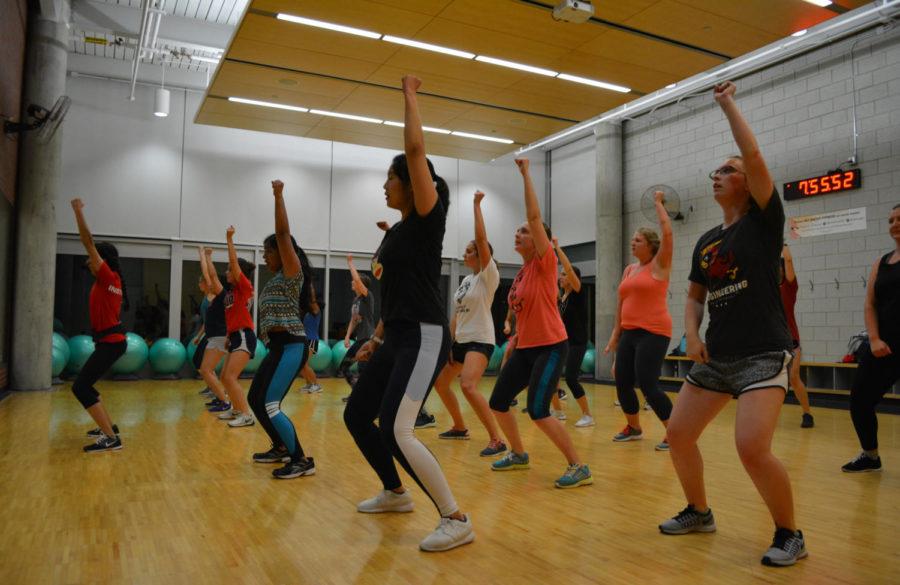Study: Having a gym membership has significant benefits
Students work out during a free Zumba class at the State Gym. ISU Recreation Services is offering free fitness classes throughout the academic year.
January 26, 2017
Adults who own gym memberships are more likely to meet U.S. physical activity guidelines than non-gym members, according to a recent study by Iowa State researchers. The study also showed that membership owners will likely experience various cardiovascular benefits.
The study, published in PLOS One Journal, showed that participants who were members of a gym were 14 times more likely to meet both aerobic and muscle strengthening guidelines, with 10 times increased odds of meeting muscle strengthening guidelines in particular. Members also exhibited various “favorable health outcomes,” which included resting heart rate, body mass index and waist circumference.
The findings, based on data received from about 400 participants, were significant enough to surprise even the team of researchers who performed the study, Elizabeth Schroeder, Iowa State graduate and co-author of the study, said.
The innovative study was one of the first to assess the correlation among a gym membership, cardiovascular health, increased exercise as well as one of the first to include weightlifting and resistance training, Schroeder said.
“It is a common question, but there is very little data [on it],” Duck-Chul Lee, assistant professor of kinesiology and co-author of the paper, said.
The specific finding that gym membership increases odds of meeting the U.S. muscle strengthening guideline is especially important because not many activities allow individuals to meet it during their everyday lives, Lee said.
“Most jobs these days are sedentary jobs,” he said.
Current physical activity guidelines recommend performing strength training at least two days a week on all major muscle groups, according to the American College of Sports Medicine.
While the dramatic increase in odds surprised Schroeder, the overall correlation between a membership and increased resistance training did not.
“When you think about resistance training and weightlifting, that’s not something that you can necessarily do easily outside of the gym,” she said. “You can do pushups and situps and things like that, but you need either to invest money or buy a gym membership if you want to do actual weightlifting.”
While she expected this particular result, some of the other results surprised her.
“One of the most interesting [findings] is that outside of the gym, people with and without a membership still did about the same amount of physical activity,” she said. “We thought that maybe if you go to the gym, then maybe you’re not as active in the rest of your life because you feel satisfied that you went and worked out.”
Instead, researchers found that the time spent at the gym was in addition to normal physical activity.
Participants in the study were mostly adults, ranging in from ages 30 to 64, but the data is still relevant to college students, Lee said.
The correlation between gym membership and increased exercise is great for Iowa State students in particular because of the available recreation services included in students’ tuition, Schroeder said.
With a valid Iowa State card, students are able to use various gyms and facilities around campus — including Lied, State Gym and Beyer Hall — participate in fitness classes, join intramural sports teams or clubs and receive free equipment training from personal trainers.
Students also have the option of using additional resources provided by Recreation Services, such as individual or group personal training, wellness services and equipment rental opportunities, according to the Iowa State Recreation Services website.
Individual motivation for owning a gym membership varies. Some people do it for health benefits, some do it to reduce stress and some do it to achieve physical appearance goals such as weight loss.
“I feel like a lot of people get a gym membership to improve their outward appearance, per say, but I think it’s good to know that while you’re approving your outward appearance you’re also benefiting your cardiovascular health at the same time,” Schroeder said.
No matter if an individual chooses to own a gym membership or not, Schroeder advocates for any physical activity possible to experience the various benefits it can bring.
“Heart disease is the number one killer in America, so anytime you can increase your fitness and help try to reduce your risk of heart disease is always good,” she said.
















